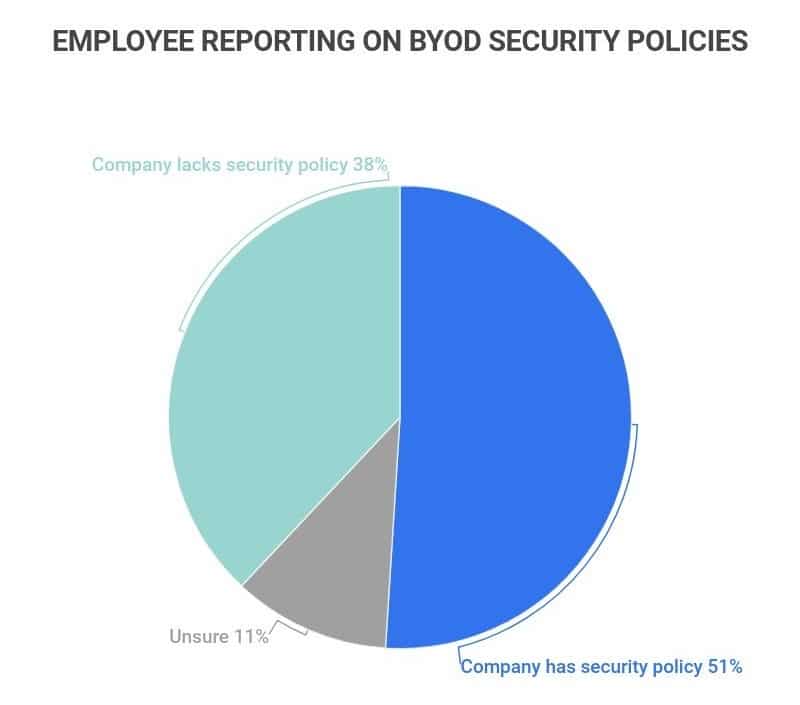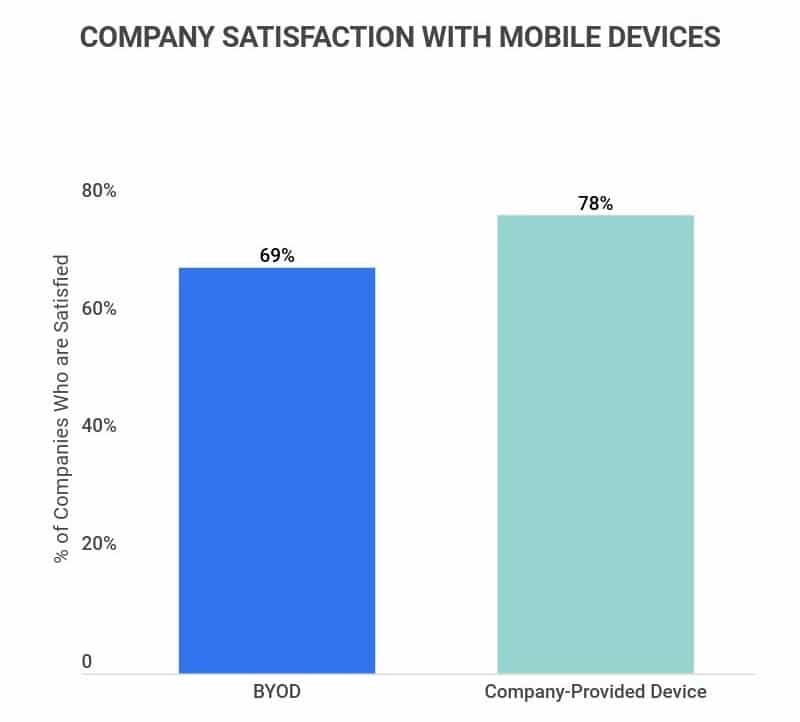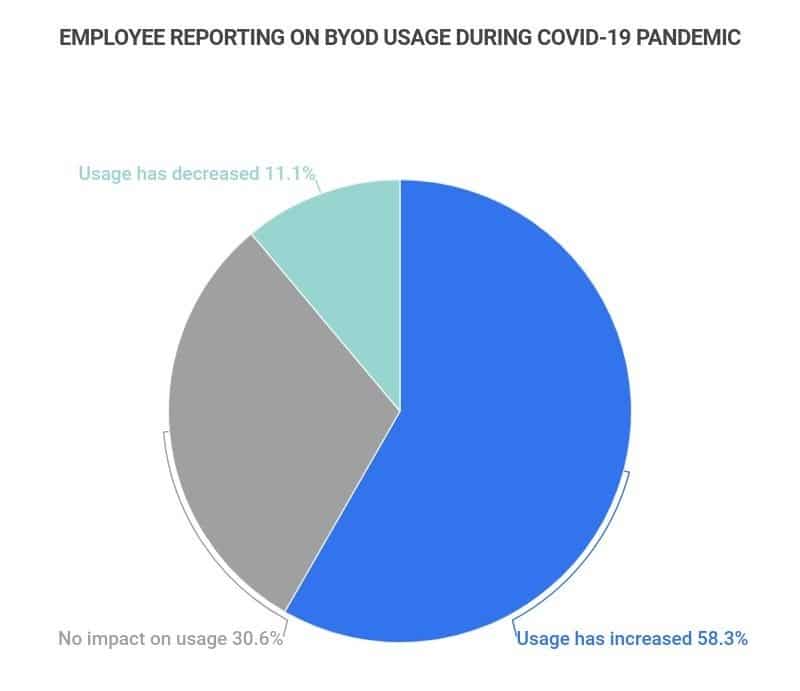- HR Statistics
- Average Labor Cost Percent Of Sales
- Average Time to Reach Profitability At A Startup
- Office Space Per Employee
- Recruitment Statistics
- Employee Engagement Statistics
- Work-Life Balance Statistics
- BYOD Statistics
- Paternity Leave Statistics
- Onboarding Statistics
- Average Paid Maternity Leave In Us
- Average Cost Of A Bad Hire
- Employee Theft Statistics
- Paid Family Leave Statistics
- Cost Of Hiring Statistics
- Employee Turnover Statistics
- Average Cost Of Employer Sponsored Health Insurance Statistics
- Sexual Harassment In The Workplace Statistics
- HR Statistics
- PTO Statistics
Research Summary. Many companies have BYOD (Bring Your Own Device) policies that allow their employees to use their personal phones and devices for their jobs. Here are some recent BYOD statistics from our data analysis team:
-
75% of employees use their personal cell phones for work.
-
It’s predicted that the BYOD market will be worth $367 billion in 2022.
-
The average BYOD policy creates $350 in revenue per year per employee.
-
83% of companies have a BYOD policy of some kind.
For further analysis, we broke down the data in the following ways:
Benefits | Problems | Policy | Employee | Trends and Predictions

General BYOD Statistics
-
80% of companies believe mobile phones are necessary for their employees to do their jobs.
-
61% of companies expect their workers to be reachable and available away from the office, whether they provide them with devices or not.
-
75% of the U.S. workforce used their personal cell phones for work prior to the COVID-19 pandemic.
-
66% of employees use smartphones for their jobs.
-
Employees use an average of 2.5 devices for work, including computers, smartphones, tablets, and e-readers.

Benefits of BYOD Statistics
-
Respondents to a 2016 survey found their productivity increased 34% when they started using smartphones for work.
More specifically, they said they gained almost an hour during their workdays and another hour during their off-hours from using a smartphone.
-
As of 2013, companies earned an average of $350 per employee per year from a BYOD policy.
This amount increases or decreases based on the specific policy, employee, and industry, of course, but it furthers the point that allowing employees to use mobile devices adds value to a company.
-
Companies save about $250 per employee per two-year contract with a BYOD plus stipend policy instead of providing devices for employees.
This number is for companies of about 500 employees, and it goes down as the company gets bigger.
If an organization doesn’t provide a stipend, this number is even higher, as the majority of the costs of a BYOD policy come from security management and any stipends paid to help employees cover the cost of their cellular and data plans.
Problems With of BYOD Statistics
-
69% of BYOD companies were satisfied with what mobile devices added to productivity, collaboration, and timely work, versus 78% of companies who provided mobile devices for a significant number of their employees.

There is an undisputed advantage to employees using mobile devices for work in any way, but companies that don’t provide any cell phones or other devices for their employees tend to see fewer of those benefits.
Companies that provide devices to at least 20% of their employees and have the rest on BYOD see the most positive results from incorporating mobile devices into their organizations.
-
Only 32% of companies require employees to register their personal devices with IT to have security software installed.
However, 50% of those same companies surveyed said that registering those devices is important. This can create significant security and privacy problems down the road for the organization, especially if an employee loses their device and there isn’t software installed that allows them to wipe it of sensitive information.
-
Over 17% of employees use their personal mobile devices for work without telling IT.
Even if a company does have a BYOD policy, employees not reporting that they’re using their phones for work can cause significant logistical and security problems, negating the benefits of a BYOD policy.
Corporate BYOD Policy Statistics
-
71% of companies provide a stipend covering at least part of employees’ BYOD mobile service plans.
More and more companies are trending this way, with some even covering all connectivity costs and part of the costs of the devices themselves. This makes BYOD options more attractive for employees and helps companies ensure employees who are using their personal devices have reliable signal and equipment.
-
83% of companies allow BYOD for at least some of their employees.
31% of these organizations don’t provide cell phones for any of their workers, 24% provide devices for less than 20%, and 28% provide phones for at least 20% of their employees.
The remaining 17% of companies provide mobile devices for all of their employees.
-
51% of employees say their employers have specific security policies for mobile devices they use for work.
37.9% said their employers don’t have policies to secure these phones, laptops, and tablets for work, and 11.1% are unsure.
Employee BYOD Statistics
-
31% of employees say they use their personal devices for work because they like having everything in one place.
-
29.3% of employees say they use their personal devices for work because their employer doesn’t provide the devices they need.
-
28.1% of employees say they choose to use their own device for work because it’s higher quality than the devices their employer provides.
-
80% of employees would rather have separate work and personal devices.
-
85% of surveyed employees said their employers pay to secure their company-provided devices, while only 49% said their employers pay to secure the personal devices they use for work.
BYOD Trends and Predictions
-
The value of the BYOD market is predicted to reach about $367 billion by 2022.
This is an over 1000% increase from 2014 when it was worth $30 billion.
The compound annual growth rate (CAGR) of the BYOD market from 2017 to 2022 is estimated to be 15%.
-
58.3% of surveyed employees said their use of personal devices for work increased during the COVID-19 pandemic.
30.6% said the pandemic had no impact on their use, and 11.1% said the amount they used their personal devices for work tasks decreased during this time.
-
It’s predicted that 30% of IT organizations will extend their BYOD policies to cover wearable technology in the workplace.
Wearable technology such as smartwatches are becoming more and more commonplace, and they’re also becoming more and more useful in workplace contexts.
That said, the more these devices are used for work purposes, the more security concerns arise. This means IT departments need to have policies to protect the company’s data and privacy with these devices.

BYOD FAQ
-
BYOD is very popular. 83% of companies have a BYOD policy of some kind.
Some of these may provide devices for some of their employees, some give their workers the option to choose to use a company-issued device or use their own, and some don’t provide any devices at all, requiring all employees to use their own.
-
Does BYOD improve productivity?
Yes, BYOD does improve productivity. 69% of companies surveyed said that they were satisfied with the improvement to productivity, collaboration, and timely work that BYOD provided.
-
BYOD is popular because it saves companies money and makes it easier for employees to work on mobile devices. Employees don’t have to learn or keep track of a new device, and employers don’t have to purchase phones and other devices for all of their employees.
-
Do employees prefer BYOD?
No, employees don’t prefer BYOD. 80% of surveyed employees say that they’d rather have separate personal and work devices than use the same device for both.
Despite their preferences, however, many employees still choose to use their own devices for their jobs even if they don’t have to.
Of those that do, about one third say they do it because they like having everything in one place, another third say they do it because their employer doesn’t provide them with the devices they need, and another third say they do it because their own devices are higher quality than the devices their employer provides.
Some employees, 17%, to be exact, don’t even tell their IT departments that they’re using their own devices for work. This is true whether or not their employers have BYOD policies such as security software that they install on employee devices to protect company data, which can cause security problems.
-
Is BYOD growing?
Yes, BYOD is growing. The BOYD market is expected to grow at a CAGR of 15% from 2017 to 2022, and it’s already seen a 1000% increase from 2014 to 2022.
Currently, 83% of companies allow at least some of their employee to bring their own devices, and that’s expected to go up. IT organizations, in particular, are embracing BYOD, and 30% of these organizations will likely extend their BYOD policies to cover wearable technology such as smartwatches in addition to the typical mobile phones, laptops, and tablets.
The COVID-19 pandemic spurred additional growth in BYOD use, as 58.3% of surveyed employees reported that they used personal devices more often during the pandemic than they did before. 30.6% said that nothing changed in this area for them, and just 11.1% said that they used their personal devices less for work than they did before the pandemic.
-
How does BYOD increase productivity?
BYOD increases productivity by making it easier for employees to communicate with colleagues and access work files away from their desks. Almost everyone has their cell phones on them at all times, which means that workers who use their mobile phones for work will always be reachable whether they’re at a doctor’s appointment or a conference.
In addition, workers are usually more familiar and comfortable with their own devices, which means that allowing them to use their own devices for work will streamline the process of learning how to work remotely. Some people also have strong opinions on which types of devices they prefer, so allowing them to choose their own will add to employee satisfaction.
The danger with BYOD policies, however, is that companies have less control over privacy and cybersecurity on these devices, so they have to put additional focus on mitigating these risks to avoid a data breach that could negate any benefits of increased productivity.
Conclusion
BYOD is now standard practice for 83% of companies. These policies do vary, though, as far as whether or not employees have the choice to use a company device or simply have to use their own and how many (if any) employees companies provide devices for.
The number one reason workers choose to use their own devices is that they like to have everything in one place. Others say they only choose this route because their employers won’t provide them with the devices they want or need, or their personal devices are of higher quality than the ones the company provides.
Companies’ can save about $300 per employee per two-year contract with a BYOD policy, as long as they take the necessary security measures to prevent much more valuable data from being compromised.
However, even though most companies recognize that security is important, only 51% of employees say they’re required to follow certain security policies, and more than 17% say they use their own devices without reporting it to IT.
The COVID-19 pandemic helped to solidify the necessity of BYOD, as 58.3% of workers said that their use of personal devices for work increased during this time. Growth in this area was already slated to grow before the pandemic, though, and in 2019 the market value of BYOD was already predicted to hit $367 billion in 2022, up from $30 billion in 2014.
References
-
Samsung. “Maximizing Mobile Value: Is BYOD Holding You Back?” Accessed on September 30, 2021.
-
Dialpad. “How To Safely Allow Employees To Use Their Personal Cell Phones for Work.” Accessed on September 30, 2021.
-
Beyond Identity. “BYOD: Exploring the Evolution of Work Device Practices in a New Remote-Forward Era [Survey].” Accessed on September 30, 2021.
-
Insights. “Employees Say Smartphones Boost Productivity by 34 Percent: Frost Sullivan Research.” Accessed on September 30, 2021.
-
Cisco. “New Analysis: Comprehensive BYOD Implementation Increases Productivity, Decreases Costs.” Accessed on September 30, 2021.
-
Socialbarrel. “Great Tips for a Successful BYOD Implementation.” Accessed on September 30, 2021.
-
BetaNews. “Growth of BYOD Proves It’s No Longer an Optional Strategy.” Accessed on September 30, 2021.
-
Gartner. “Gartner Unveils Top Predictions for IT Organizations and Users in 2020 and Beyond.” Accessed on September 30, 2021.
- HR Statistics
- Average Labor Cost Percent Of Sales
- Average Time to Reach Profitability At A Startup
- Office Space Per Employee
- Recruitment Statistics
- Employee Engagement Statistics
- Work-Life Balance Statistics
- BYOD Statistics
- Paternity Leave Statistics
- Onboarding Statistics
- Average Paid Maternity Leave In Us
- Average Cost Of A Bad Hire
- Employee Theft Statistics
- Paid Family Leave Statistics
- Cost Of Hiring Statistics
- Employee Turnover Statistics
- Average Cost Of Employer Sponsored Health Insurance Statistics
- Sexual Harassment In The Workplace Statistics
- HR Statistics
- PTO Statistics





